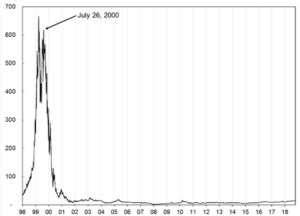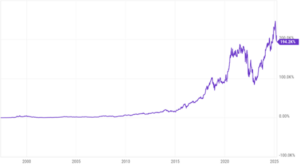Buying the Dip
April 2, 2025
To Inform:
“When do I buy the dip in XYZ stock?” or “should I be worried about the dip in XYZ stock?” These are questions we’ve received quite a few times this year as it relates to individual stocks or even stock market indexes like the S&P 500. In attempting to answer that question, I think it makes sense to talk a little about the broader concept of market volatility and how that impacts the prices of stocks.
It has been said many times and in many places that when it comes to investing, “volatility is a feature, not a bug.” Volatility in individual stocks and in the collective market is a function of the ever-changing expectations and ever-changing time horizons that investors collectively apply to stocks. It might be helpful to think about this through the lens of a person looking to buy a business.
For the prospective business buyer, what are the most important questions they might ask? Questions that might shed light on cash flow potential make a lot of sense. The more insight into cash flows a prospective buyer may have the greater their confidence is likely to be. Another very important question is how much is the business being sold for? In fact, these two things are closely linked. A business with highly visible and growing cash flows over time is likely going to cost the prospective buyer more than a business without those features.
But what happens if a business with visible and growing cash flows enters a period of uncertainty? That scrambles the valuation calculation considerably. That is precisely what happens at a larger scale when market volatility introduces itself either individually with a company’s stock or a collection of stocks, i.e. the market in general. In the first quarter of 2025 we’ve seen this happen at the company level – “what does a low-cost Chinese artificial intelligence model mean for this kind of stock or set of stocks?” We’ve also seen this happen at the macroeconomic level – “what do tariffs mean for corporate earnings and business investment?” These questions have given investors more uncertainty about the future and, as a result, these questions have given investors cause to want to pay less for those stocks than they were willing to pay when uncertainty was lower.
At The Joseph Group, our answer to so many of these questions often leads back to “what does your plan look like?”. If your financial plan is in good shape and you have confidence in the long-term, deploying a little bit of capital when uncertainty is elevated may be a very healthy thing to do. But aside from whether your plan can accommodate the risk of some dip buying, another question every investor needs to ask themselves (and be comfortable with the uncertainty in answering) is “how much have things changed?” The chart below shows the long-term returns of a stock whose long-term prospects had indeed changed. Investors who bought the dip in this stock at various points in the early 2000s ended up sorely disappointed. Contrast that with the very differently shaped chart from YCharts. This company’s stock had some eye-popping dips in the past that hardly even register today. Gains in share price since the early 2000s have been so large that a 90% dip (is that even the best word to describe a 90% decline?) in this stock is hardly visible on the chart. In that “dip,” valuations came down as uncertainty about the business grew higher. For those who had faith in the long-term prospects of the business that dip was a great time to buy. Markets will always do this (again, a feature not a bug) and it’s why returns to investing in stocks, in aggregate, have dwarfed the returns of cash and bonds throughout history.

Source: LinkedIn

Source: YCharts
Investment fundamentals remain unchanged regardless of current market conditions. Stay diversified, buy companies with good fundamentals, and stay invested through market ups and downs for the long-term portion of your portfolio. And see market dips as an opportunity to add to a well-diversified and fundamentally sound investment portfolio.

Written by Alex Durbin, CFA, Chief Investment Officer